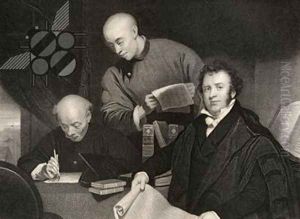After Chinnery, George (1774-1852) Paintings
George Chinnery was an English painter who is best known for his portraits and landscapes in the British colonies, particularly India and southern China. Born on January 5, 1774, in London, Chinnery came from a family with an artistic background. His father, also George Chinnery, was a successful sculptor and provided his son with an early education in the arts.
Chinnery began his artistic training at the Royal Academy Schools in London. He showed great promise and won several prizes during his time there. In his early career, he established himself as a portrait artist. In search of new opportunities and inspired by the prospects of the East, Chinnery left England for India in 1802. He initially settled in Madras (now Chennai) and later moved to Calcutta (now Kolkata), where he became the leading portraitist, capturing the likenesses of both European expatriates and wealthy Indian patrons.
As a painter, Chinnery was highly esteemed for his ability to capture the character and social standing of his subjects. His charming and insightful portraits were much in demand, and he enjoyed considerable success. However, Chinnery was also known for his financial irresponsibility and accumulated debts, which eventually drove him to leave India.
In 1825, Chinnery moved to China to escape his creditors, settling first in Canton (now Guangzhou) and later in Macau. His work in China broadened to include not only portraits but also numerous landscapes and scenes of Chinese daily life. These works are particularly valued for their historical significance as they provide a rare glimpse of life in southern China during the early 19th century.
Throughout his life, Chinnery was a prolific artist, and his style was characterized by a loose, free brushwork that was well suited to capturing the ambiance of the colonial tropics. He continued to work until his death in Macau on May 30, 1852. Today, George Chinnery's work is held in high esteem, and his paintings can be found in major collections around the world, offering an invaluable visual record of a bygone era in British colonial history.
